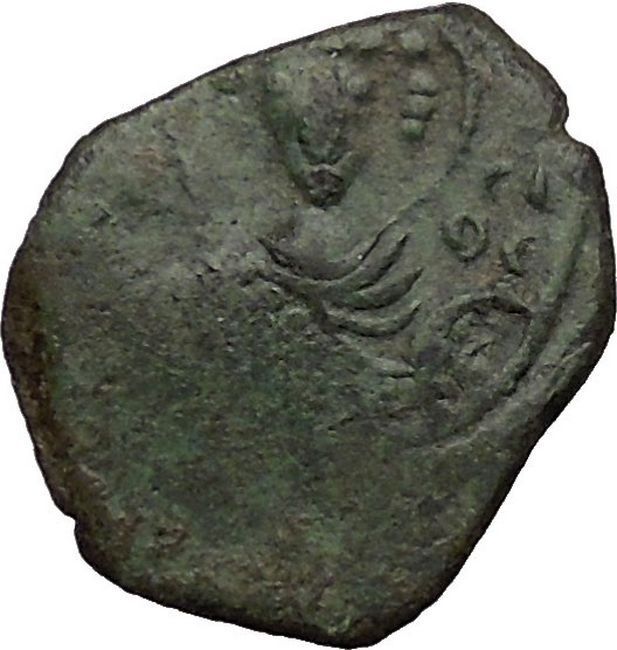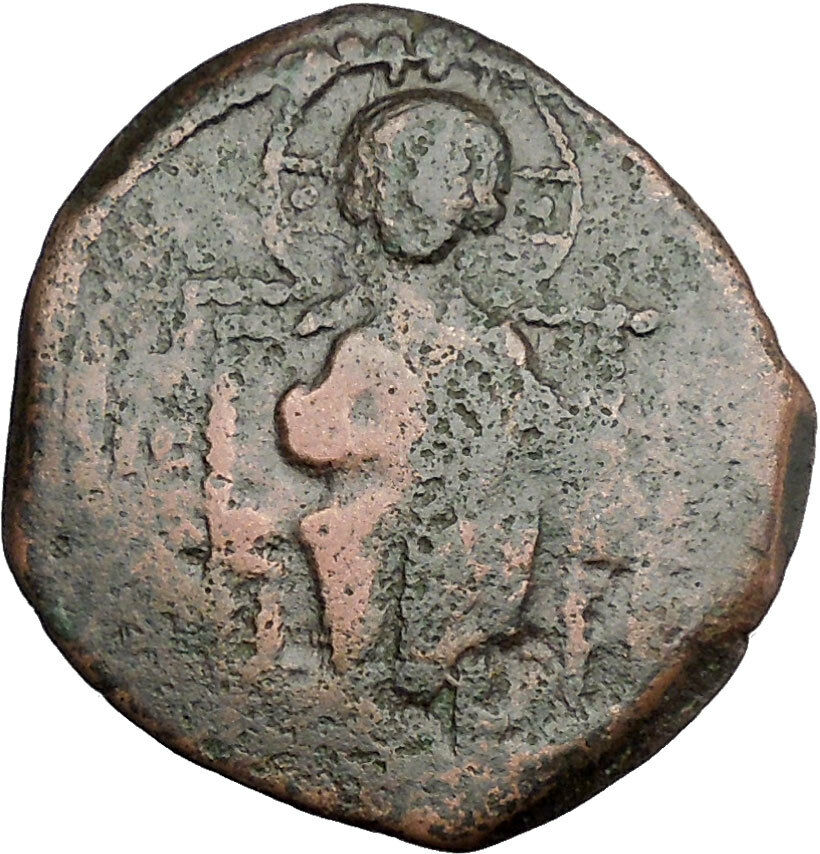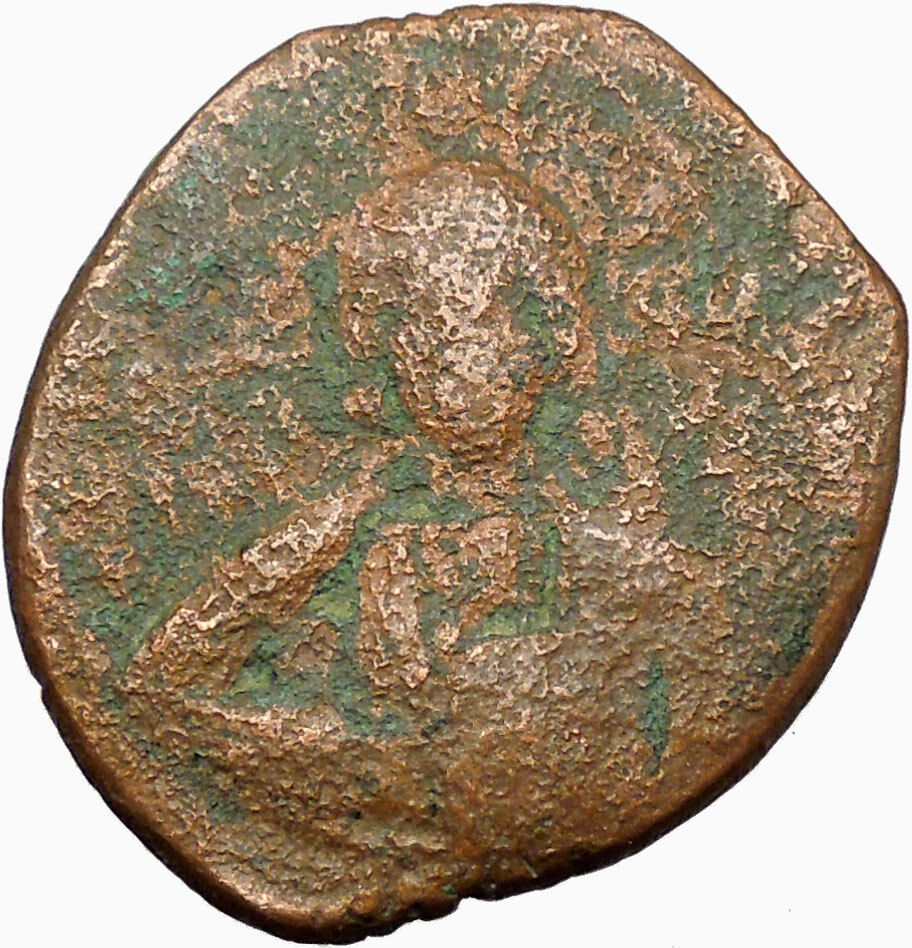|
Byzantine Empire
Anonymous Class K
Bronze Follis 24mm (3.71 grams)
Struck during the reign of Alexius I, Comnenus
Byzantine Emperor: 4 April 1081 – 15 August 1118 A.D.
Reference: Sear 1901
Bust of Christ facing , wearing a nimbus crown, pallium and colobium, and raising right hand in benediction; in left hand, book of Gospels; to left, IC; to right, XC; border of large pellets.
Three-qauarter length figure of the Virgin orans, nimbate and wearing pallium and maphorium; on either side of nimbus, M – Θ or MP – ΘV; border of large pellets.
* Numismatic Note: Alexius I was the Byzantine emperor during the time of the First Crusade.
For more than a century, the production of Follis denomination Byzantine coins had religious Christian motifs which included included Jesus Christ, and even Virgin Mary. These coins were designed to honor Christ and recognize the subservient role of the Byzantine emperor, with many of the reverse inscriptions translating to “Jesus Christ King of Kings” and “May Jesus Christ Conquer”. The Follis denomination coins were the largest bronze denomination coins issued by the Byzantine empire, and their large size, along with the Christian motif make them a popular coin type for collectors. This series ran from the period of Byzantine emperors John I (969-976 A.D.) to Alexius I (1081-1118 A.D.). The accepted classification was originally devised by Miss Margaret Thompson with her study of these types of coins. World famous numismatic author, David R. Sear adopted this classification system for his book entitled, Byzantine Coins and Their Values. The references about this coin site Mr. Sear’s book by the number that they appear in that work. The class types of coins included Class A1, Class A2, Class B, Class C, Class D, Class E, Class F, Class G, Class H, Class I, Class J, Class K. Read more and see examples of these coins by reading the JESUS CHRIST Anonymous Class A-N Byzantine Follis Coins Reference.
Click here to see all the Jesus Christ Anonymous Follis coins for sale.
Click here to see all coins bearing Jesus Christ or related available for sale.
You are bidding on the exact item pictured, provided with a Certificate of Authenticity and Lifetime Guarantee of Authenticity.
Jesus of Nazareth (c. 5 BC/BCE – c. 30 AD/CE), also referred to as Jesus Christ or simply Jesus, is the central figure of Christianity. Most Christian denominations venerate him as God the Son incarnated and believe that he rose from the dead after being crucified.
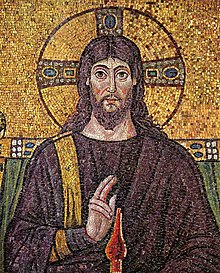 The principal sources of information regarding Jesus are the four canonical gospels, and most critical scholars find them, at least the Synoptic Gospels, useful for reconstructing Jesus’ life and teachings. Some scholars believe apocryphal texts such as the Gospel of Thomas and the Gospel according to the Hebrews are also relevant. The principal sources of information regarding Jesus are the four canonical gospels, and most critical scholars find them, at least the Synoptic Gospels, useful for reconstructing Jesus’ life and teachings. Some scholars believe apocryphal texts such as the Gospel of Thomas and the Gospel according to the Hebrews are also relevant.
Most critical historians agree that Jesus was a Jew who was regarded as a teacher and healer, that he was baptized by John the Baptist, and was crucified in Jerusalem on the orders of the Roman Prefect Judaea, Pontius Pilate, on the charge of sedition against the Roman Empire. Critical Biblical scholars and historians have offered competing descriptions of Jesus as a self-described Messiah, as the leader of an apocalyptic movement, as an itinerant sage, as a charismatic healer, and as the founder of an independent religious movement. Most contemporary scholars of the Historical Jesus consider him to have been an independent, charismatic founder of a Jewish restoration movement, anticipating an imminent apocalypse. Other prominent scholars, however, contend that Jesus’ “Kingdom of God” meant radical personal and social transformation instead of a future apocalypse.
Christians traditionally believe that Jesus was born of a virgin:529–32 performed miracles,:358–59 founded the Church, rose from the dead, and ascended into heaven,:616–20 from which he will return.:1091–109 Most Christian scholars today present Jesus as the awaited Messiah promised in the Old Testament and as God, arguing that he fulfilled many Messianic prophecies of the Old Testament. The majority of Christians worship Jesus as the incarnation of God the Son, one of three divine persons of a reject Trinitarianism Trinity, wholly or partly, believing it to be non-scriptural.
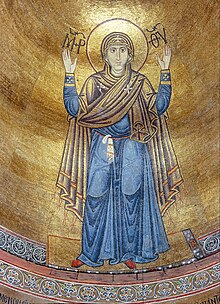 The Virgin Orans, Oranta (The Great Panagia) (Ukrainian: Оранта) is a well-known Orthodox Christian depiction of the Virgin Mary in prayer with extended arms. It is stored in the Saint Sophia Cathedral in Kiev in Ukraine. The 6-meter-high mosaic is located in the vault of the chancel. The icon has been present in the cathedral since its foundation by Yaroslav I the Wise in the 12th century. The Virgin Orans, Oranta (The Great Panagia) (Ukrainian: Оранта) is a well-known Orthodox Christian depiction of the Virgin Mary in prayer with extended arms. It is stored in the Saint Sophia Cathedral in Kiev in Ukraine. The 6-meter-high mosaic is located in the vault of the chancel. The icon has been present in the cathedral since its foundation by Yaroslav I the Wise in the 12th century.
The Virgin’s solemn and static posture, the characteristic folds of her garments, and her pensive expression indicate the design was strongly influenced by Byzantine art.
The image is considered as one of the greatest sacred symbols in Ukraine, a palladion defending the people of the country. It has been called an “Indestructible Wall” or “Unmoveable Wall”. Legend says that as long as the Theotokos is extending Her arms over Kiev, the city will stand indestructible.
The embroidered handkerchief on the belt of the Mother of God is popularly thought to be for wiping away the tears of those who come before her with their problems and concerns.
In 1997, the National Bank of Ukraine issued commemorative coins “Orante” (“Oranta”) within the “Spiritual Treasures of Ukraine” series.
The First Crusade (1096–1099) started as a widespread pilgrimage (France and Germany) and ended as a military expedition by Roman Catholic Europe to regain the Holy Lands taken in the Muslim conquests of the Levant (632–661), ultimately resulting in the recapture of Jerusalem in 1099. It was launched on 27 November 1095 by Pope Urban II with the primary goal of responding to an appeal from Byzantine Emperor Alexios I Komnenos, who requested that western volunteers come to his aid and help to repel the invading Seljuq Turks from Anatolia. An additional goal soon became the principal objective—the Christian reconquest of the sacred city of Jerusalem and the Holy Land and the freeing of the Eastern Christians from Islamic rule.
During the crusade, knights and peasants from many nations of Western Europe travelled over land and by sea, first to Constantinople and then on towards Jerusalem. The Crusaders arrived at Jerusalem, launched an assault on the city, and captured it in July 1099, massacring many of the city’s Muslim, Christian, and Jewish inhabitants. They also established the crusader states of the Kingdom of Jerusalem, the County of Tripoli, the Principality of Antioch, and the County of Edessa.
Because the First Crusade was largely concerned with Jerusalem, a city which had not been under Christian dominion for 461 years, and the crusader army refused to return the land to the control of the Byzantine Empire, the status of the First Crusade as defensive or as aggressive in nature remains controversial.
The First Crusade was part of the Christian response to the Muslim conquests, and was followed by the Second through Ninth Crusades, but the gains made lasted for less than 200 years. It was also the first major step towards reopening international trade in the West since the fall of the Western Roman Empire.
Alexios I Komnenos, Latinized as Alexius I Comnenus (Greek: Ἀλέξιος Α’ Κομνηνός, 1056 – 15 August 1118—note that some sources list his date of birth as 1048), was Byzantine emperor from 1081 to 1118, and the  founder of the Komnenian dynasty. Inheriting a collapsing empire and faced with constant warfare during his reign against both the Seljuk Turks in Asia Minor and the Normans in the western Balkans, Alexios was able to halt the Byzantine decline and begin the military, financial, and territorial recovery known as the “Komnenian restoration“. His appeals to Western Europe for help against the Turks were also the catalyst that triggered the Crusades. founder of the Komnenian dynasty. Inheriting a collapsing empire and faced with constant warfare during his reign against both the Seljuk Turks in Asia Minor and the Normans in the western Balkans, Alexios was able to halt the Byzantine decline and begin the military, financial, and territorial recovery known as the “Komnenian restoration“. His appeals to Western Europe for help against the Turks were also the catalyst that triggered the Crusades.
//
Life
Alexios was the son of Ioannis Komnenos and Anna Dalassena, and the nephew of Isaac I Komnenos (emperor 1057–1059). Alexios’ father declined the throne on the abdication of Isaac, who was accordingly succeeded by four emperors of other families between 1059 and 1081. Under one of these emperors, Romanos IV Diogenes (1067–1071), he served with distinction against the Seljuk Turks. Under Michael VII Doukas Parapinakes (1071–1078) and Nikephoros III Botaneiates (1078–1081), he was also employed, along with his elder brother Isaac, against rebels in Asia Minor, Thrace, and in Epirus.
Alexios’ mother wielded great influence during his reign, and he is described by his daughter, the historian Anna Komnene, as running next to the imperial chariot that she drove. In 1074, the rebel mercenaries in Asia Minor were successfully subdued, and, in 1078, he was appointed commander of the field army in the West by Nikephoros III. In this capacity, Alexios defeated the rebellions of Nikephoros Bryennios the Elder (whose son or grandson later married Alexios’ daughter Anna) and Nikephoros Basilakes, the first at the Battle of Kalavrye and the latter in a surprise night attack on his camp. Alexios was ordered to march against his brother-in-law Nikephoros Melissenos in Asia Minor but refused to fight his kinsman. This did not, however, lead to a demotion, as Alexios was needed to counter the expected invasion of the Normans of Southern Italy, led by Robert Guiscard.
Conspiracy and revolt of the Komnenoi against Botaneites
While the Byzantine troops were assembling for the expedition, Alexios was approached by the Doukas faction at court, who convinced him to join a conspiracy against Nikephoros III. The mother of Alexios, Anna Dalassena, was to play a prominent role in this coup d’état of 1081, along with the current empress, Maria of Alania. First married to Michael VII Doukas and secondly to Nikephoros III Botaneiates, she was preoccupied with the future of her son by Michael VII, Constantine Doukas. Nikephoros III intended to leave the throne to one of his close relatives, and this resulted in Maria’s ambivalence and alliance with the Komnenoi. The real driving force behind this political alliance was Anna Dalassene.
Already closely connected to the Komnenoi through Maria’s cousin Irene to Isaac Komnenos, the Komnenoi brothers were able to see the empress under the pretense of a friendly family visit. Furthermore, to aid the conspiracy Maria had adopted Alexios as her son, though she was only five years older than he Maria was persuaded to do so on the advice of her own “Alans” and her eunuchs, who had been instigated to do his by Isaac Komnenos. Knowing Anna’s tight hold on her family, it must have been with her implicit approval that he be adopted. As a result, Alexios and Constantine, Maria’s son, were now adoptive brothers and both Isaac and Alexios took an oath that they would safeguard his rights as emperor. By secretly giving inside information to the Komnenoi, Maria was an invaluable ally.
As stated in the Alexiad, Isaac and Alexios left Constantinople in mid-February 1081 to raise an army against Botaneiates. However, when the time came, Anna quickly and surreptitiously mobilized the remainder of the family and took refuge in the Hagia Sophia. From there she negotiated with the emperor for the safety of family members left in the capital, while protesting her sons’ innocence of hostile actions; under the falsehood of making a vesperal visit to worship at the church, she deliberately excluded the grandson of Botaneiates and his loyal tutor, met with Alexios and Isaac and fled for the forum of Constantine. The tutor found them missing and eventually found them on the palace grounds but she was able to convince him that they would return to the palace shortly. Then to gain entrance to both the outer and inner sanctuary of the church the women pretended to the gatekeepers that they were pilgrims from Cappadocia who had spent all their funds and wanted to worship before starting their return trip. However, before they were to gain entry into the sanctuary, Straboromanos and royal guards caught up with them to summon them back to the palace. Anna then protested that the family was in fear for their lives, her sons were loyal subjects (Alexios and Isaac were discovered absent without leave), and had learned of a plot by enemies of the Komnenoi to have them both blinded and had, therefore, fled the capital so they may continue to be of loyal service to the emperor. She refused to go with them and demanded that they allow her to pray to the Mother of God for protection. This request was granted and Anna then manifested her true theatrical and manipulative capabilities: “She was allowed to enter. As if she were weighed down with old age and worn out by grief, she walked slowly and when she approached the actual entrance to the sanctuary made two genuflections; on the third she sank to the floor and taking firm hold of the sacred doors, cried in a loud voice: “Unless my hands are cuff off, I will not leave this holy place except on one condition: that I receive the emperor’s cross as guarantee of safety”.
Nikephoros III Botaneiates was forced into a public vow that he would grant protection to the family. Straboromanos tried to give her his cross, but for Anna this was not sufficiently large enough so that all bystanders could witness the oath. She also demanded that the cross be personally sent by Botaneiates as a vow of his good faith. He obliged, sending a complete assurance for the family with his own cross. At the emperor’s further insistence, and for their own protection they took refuge at the convent of Petrion, where eventually they were joined by Irene Doukaina’s mother, Maria of Bulgaria.
Botaneiates allowed them to be treated as refugees rather than guests. They were allowed to have family members bring in their own food and were on good terms with the guards from whom they learned the latest news. Anna was highly successful in three important aspects of the revolt: she bought time for her sons to steal imperial horses from the stables and escape the city, she distracted the emperor and gave her sons time to gather and arm their troops and she gave a false sense of security to Botaneiates that there was no real treasonous coup against him. After bribing the Western troops who had guarded the city, Isaac and Alexios Komnenos entered the capital victoriously on April 1, 1081.
During this time, Alexios was rumored to be the lover of Empress Maria of Alania, the daughter of King Bagrat IV of Georgia, who had been successively married to Michael VII Doukas and his successor Nikephoros III Botaneiates, renowned for her beauty. Alexios arranged for Maria to stay on the palace grounds, and it was thought that Alexios was considering marrying the erstwhile empress. However, his mother consolidated the Doukas family connection by arranging the Emperor’s marriage to Irene Doukaina, granddaughter of the Caesar John Doukas, the uncle of Michael VII, who would not have supported Alexios otherwise. As a measure intended to keep the support of the Doukai, Alexios restored Constantine Doukas, the young son of Michael VII and Maria, as co-emperor and a little later betrothed him to his own first-born daughter Anna, who moved into the Mangana Palace with her fiancé and his mother.
However, this situation changed drastically when Alexios’ first son John II Komnenos was born in 1087: Anna’s engagement to Constantine was dissolved, and she was moved to the main Palace to live with her mother and grandmother. Alexios became estranged from Maria, who was stripped of her imperial title and retired to a monastery, and Constantine Doukas was deprived of his status as co-emperor. Nevertheless, he remained in good relations with the imperial family and succumbed to his weak constitution soon afterwards.
Wars against the Normans, Pechenegs and Tzachas
Alexios’ long reign of nearly thirty-seven years was full of struggle. At the very outset, he had to meet the formidable attack of the Normans (led by Robert Guiscard and his son Bohemund), who took Dyrrhachium and Corfu, and laid siege to Larissa in Thessaly (see Battle of Dyrrhachium). Alexios suffered several defeats before being able to strike back with success. He enhanced this by bribing the German king Henry IV with 360,000 gold pieces to attack the Normans in Italy, which forced the Normans to concentrate on their defenses at home in 1083–1084. He also secured the alliance of Henry, Count of Monte Sant’Angelo, who controlled the Gargano Peninsula and dated his charters by Alexios’ reign. Henry’s allegiance was to be the last example of Byzantine political control on peninsular Italy. The Norman danger ended for the time being with Robert Guiscard’s death in 1085, and the Byzantines recovered most of their losses.
Next, Alexios had to deal with disturbances in Thrace, where the heretical sects of the Bogomils and the Paulicians revolted and made common cause with the Pechenegs from beyond the Danube. Paulician soldiers in imperial service likewise deserted during Alexios’ battles with the Normans. As soon as the Norman threat had passed, Alexios set out to punish the rebels and deserters, confiscating their lands. This led to a further revolt near Philippopolis, and the commander of the field army in the west, Gregory Pakourianos, was defeated and killed in the ensuing battle. In 1087 the Pechenegs raided into Thrace and Alexios crossed into Moesia to retaliate but failed to take Dorostolon (Silistra). During his retreat, the emperor was surrounded and worn down by the Pechenegs, who forced him to sign a truce and pay protection money. In 1090 the Pechenegs invaded Thrace again, while Tzachas, the brother-in-law of the Sultan of Rum, launched a fleet and attempted to arrange a joint siege of Constantinople with the Pechenegs. Alexios overcame this crisis by entering into an alliance with a horde of 40,000 Cumans, with whose help he crushed the Pechenegs at Levounion in Thrace on 29 April 1091.
This put an end to the Pecheneg threat, but in 1094 the Cumans began to raid the imperial territories in the Balkans. Led by a pretender claiming to be Constantine Diogenes, a long-dead son of the Emperor Romanos IV, the Cumans crossed the mountains and raided into eastern Thrace until their leader was eliminated at Adrianople. With the Balkans more or less pacified, Alexios could now turn his attention to Asia Minor, which had been almost completely overrun by the Seljuk Turks.
Byzantine-Seljuk Wars and the First Crusade
By the time Alexios ascended the throne, the Seljuks had taken most of Asia Minor. Alexios was able to secure much of the coastal regions by sending peasant soldiers to raid the Seljuk camps, but these victories were unable to stop the Turks ltogether. As early as 1090, Alexios had taken reconciliatory measures towards the Papacy, with the intention of seeking western support against the Seljuks. In 1095 his ambassadors appeared before Pope Urban II at the Council of Piacenza. The help which he wanted from the West was simply mercenary forces and not the immense hosts which arrived, to his consternation and embarrassment, after the pope preached the First Crusade at the Council of Clermont later that same year. Not quite ready to supply this number of people as they traversed his territories, the emperor saw his Balkan possessions subjected to further pillage at the hands of his own allies. Alexios dealt with the first disorganized group of Crusaders, led by the preacher Peter the Hermit, by sending them on to Asia Minor, where they were massacred by the Turks in 1096.
The second and much more formidable host of crusaders gradually made its way to Constantinople, led in sections by Godfrey of Bouillon, Bohemund of Taranto, Raymond IV of Toulouse and other important members of the western nobility. Alexios used the opportunity of meeting the crusader leaders separately as they arrived and extracting from them oaths of homage and the promise to turn over conquered lands to the Byzantine Empire. Transferring each contingent into Asia, Alexios promised to supply them with provisions in return for their oaths of homage. The crusade was a notable success for Byzantium, as Alexios now recovered a number of important cities and islands. The crusader siege of Nicaea forced the city to surrender to the emperor in 1097, and the subsequent crusader victory at Dorylaion allowed the Byzantine forces to recover much of western Asia Minor. John Doukas re-established Byzantine rule in Chios, Rhodes, Smyrna, Ephesus, Sardis, and Philadelphia in 1097–1099. This success is ascribed by Alexios’ daughter Anna to his policy and diplomacy, but by the Latin historians of the crusade to his treachery and falseness. In 1099, a Byzantine fleet of 10 ships were sent to assist the Crusaders in capturing Laodicea and other coastal towns as far as Tripoli. The crusaders believed their oaths were made invalid when the Byzantine contingent under Tatikios failed to help them during the siege of Antioch; Bohemund, who had set himself up as Prince of Antioch, briefly went to war with Alexios in the Balkans, but was blockaded by the Byzantine forces and agreed to become Alexios’ vassal by the Treaty of Devol in 1108.
Personal life
During the last twenty years of his life Alexios lost much of his popularity. The years were marked by persecution of the followers of the Paulician and Bogomil heresies—one of his last acts was to publicly burn at the stake Basil, a Bogomil leader, with whom he had engaged in a theological dispute. In spite of the success of the crusade, Alexios also had to repel numerous attempts on his territory by the Seljuks in 1110–1117.
Alexios was for many years under the strong influence of an eminence grise, his mother Anna Dalassene, a wise and immensely able politician whom, in a uniquely irregular fashion, he had crowned as Augusta instead of the rightful claimant to the title, his wife Irene Doukaina. Dalassena was the effective administrator of the Empire during Alexios’ long absences in military campaigns: she was constantly at odds with her daughter-in-law and had assumed total responsibility for the upbringing and education of her granddaughter Anna Komnene.
Succession
Alexios’ last years were also troubled by anxieties over the succession. Although he had crowned his son John II Komnenos co-emperor at the age of five in 1092, John’s mother Irene Doukaina wished to alter the succession in favor of her daughter Anna and Anna’s husband, Nikephoros Bryennios the Younger. Bryennios had been made kaisar (Caesar) and received the newly-created title of panhypersebastos (“honoured above all”), and remained loyal to both Alexios and John. Nevertheless, the intrigues of Irene and Anna disturbed even Alexios’ dying hours.
|





 The principal sources of information regarding Jesus are the four canonical gospels, and most critical scholars find them, at least the Synoptic Gospels, useful for reconstructing Jesus’ life and teachings. Some scholars believe apocryphal texts such as the Gospel of Thomas and the Gospel according to the Hebrews are also relevant.
The principal sources of information regarding Jesus are the four canonical gospels, and most critical scholars find them, at least the Synoptic Gospels, useful for reconstructing Jesus’ life and teachings. Some scholars believe apocryphal texts such as the Gospel of Thomas and the Gospel according to the Hebrews are also relevant. The Virgin Orans, Oranta (The Great Panagia) (Ukrainian:
The Virgin Orans, Oranta (The Great Panagia) (Ukrainian:  founder of the Komnenian dynasty. Inheriting a collapsing empire and faced with constant warfare during his reign against both the Seljuk Turks in Asia Minor and the Normans in the western Balkans, Alexios was able to halt the Byzantine decline and begin the military, financial, and territorial recovery known as the “Komnenian restoration“. His appeals to Western Europe for help against the Turks were also the catalyst that triggered the Crusades.
founder of the Komnenian dynasty. Inheriting a collapsing empire and faced with constant warfare during his reign against both the Seljuk Turks in Asia Minor and the Normans in the western Balkans, Alexios was able to halt the Byzantine decline and begin the military, financial, and territorial recovery known as the “Komnenian restoration“. His appeals to Western Europe for help against the Turks were also the catalyst that triggered the Crusades.

